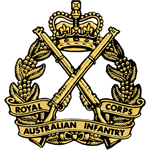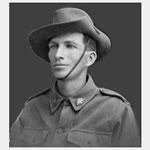Commemorated: | |||
| 1. Memorial: | Buttes New British Cemetery, Polygon Wood | I. E. 19. | |
| 2. Book: | The (1921) Masonic Roll of Honour 1914-1918 | Pg.126 | |
| 3. Memorial: | The (1940) Scroll - WW1 Roll of Honour | 45D GQS | |
Awards & Titles: | |||
Family :
Son of Henry Hunter of Nanango Queensland. Timber CutterService Life:
Campaigns:
- The First World War 1914-1918, World-wide.
| Unit / Ship / Est.: 49/Australian Infantry, A.I.F. |
Mike: BEAN 13th Brigade-Q?land, S ?Airst, U? .gust Tns , 49th, SOfk, 51st, 152iid disbanded), Bus -1q3, 353n, 486, < I I , 6oin, 717n. 888. 1067n. reduced to three bns, 68n; nr. Sailly- Laurette, IO-11 lunr. 227n, 231. 235. cas, zjon: |
| Action : The Battles of Ypres 1917 (Third Ypres, or Passchendaele) |
31 July - 10 November 1917. By the summer of 1917 the British Army was able for the first time to fight on its chosen ground on its terms. Having secured the southern ridges of Ypres at Messines in June, the main attack started on 31st July 1917 accompanied by what seemed like incessant heavy rain, which coupled with the artillery barrages conspired to turn much of the battlefield into a bog. Initial failure prompted changes in the high command and a strategy evolved to take the ring of ridges running across the Ypres salient in a series of 'bite and hold' operations, finally culminating in the capture of the most easterly ridge on which sat the infamous village of Passchendaele. The Official History carries the footnote ?The clerk power to investigate the exact losses was not available? but estimates of British casualties range from the official figure of 244,000 to almost 400,000. Within five months the Germans pushed the British back to the starting line, which was where they had been since May 1915.
Detail :
Private John (Jack) HUNTER,49/Australian Infantry AIF. At the beginning of September 2006, the remains of five Australian soldiers were found at Zonnebeke. They were found by a team of the Memorial Museum Passchendaele 1917 and the archaeological service Archeo7, during excavations for a new gas main at the hamlet of Westhoek in Zonnebeke. Four of the five skeletons were folded in blankets, tied up with copper-wire. The human remains of the fifth one were exceptionally well kept, covered with a ground sheet. Parts of their clothes, footgear and some badges told us their nationality. On one of the bodies, a two part colour patch from the 4th Australian Division was found. The location where the human remains were found is situated in the no man's land of that division from 22 to 30 September 1917. The battalions 45 until 52 counted 136 missing soldiers during that period, all mentioned on the Ypres Menin Gate. Most of the victims fell on 26 September during the Battle of Polygon Wood and during artillery shelling the following days. A medical evacuation track passed not far from that location. At least 30 of the missing soldiers were found buried in a small cemetery close by. The burial ground was evacuated after the war, whereby most of the casualties were laid to rest as unknown. The reason for this being that their personal belongings had been sent back to Australia on original internment and the crosses which marked their graves had disappeared, most during the subsequent fighting.
Somehow the remains of the 5 Australians were overlooked during the post-war clearance, probably because there was already a road covering their remains. Thanks to the intervention of the Belgian War Graves Department, a DNA sample of each of the five remains was taken. Meanwhile from four of the five casualties, age and cause of death were discovered after forensic research. After intensive investigation by the Australian authorities and with the help of the Australian media, relatives of three possible casualties were found. Their genetic data was posted to Belgium where for two of the three parties involved unmistakable resemblances were found.
Skeleton no. 5 has been identified as Private 3504 John (Jack) Hunter of the 49th Battalion AIF from Nanango, Queensland. He was born on 21 August 1889 in Jimboomba as the eldest son of Henry ('Harry') and Emily Hunter. When the family moved to Nanango in 1908, they already had seven children. Their father Harry had been granted a timber contract logging virgin scrub and the family also started grazing cattle. Business went so well that in 1910 a steam traction engine could be introduced. Besides being his father's 'righthand' man, John was a good rugby player and also enjoyed racing horses. He was captain of the Nanango rugby team, got a certificate for the Ipswich Racing club and was also a Master Mason of the local Masonic Lodge (Nanango #2873 EC). On 25 October 1916 John Hunter enlisted together with his two years younger brother James (Jim), only to arrive at the Western front by mid August 1917. On 26 September 1917 the 4th Division attacked in the direction of Zonnebeke village, east of Polygon Wood. For his baptism of fire, John immediately volunteered as a runner and was shot on leaving the trenches. He died in the arms of his younger brother Jim, who helped to bury him. Jim returned to Australia on 1 May 1919. It took another 88 years before Jack's body was discovered. Originally buried at 28NE J7 B.7.7
Masonic :
| Type | Lodge Name and No. | Province/District : |
|---|---|---|
| Mother : | Nanango No. 2873 E.C. | Unknown |
Initiated | Passed | Raised |
29th March 1915 | 26th July 1915 | 6th September 1915 |
Source :
The project globally acknowledges the following as sources of information for research across the whole database:
- The Commonwealth War Graves Commission
- The (UK) National Archives
- Ancestry.co.uk - Genealogy, Family Trees & Family History online
- ugle.org.uk - The records of the United Grand Lodge of England including the Library and Museum of Freemasonry
Additional Source:
- Founder Researchers : Paul Masters & Mike McCarthy
- Researcher : Bruce Littley

